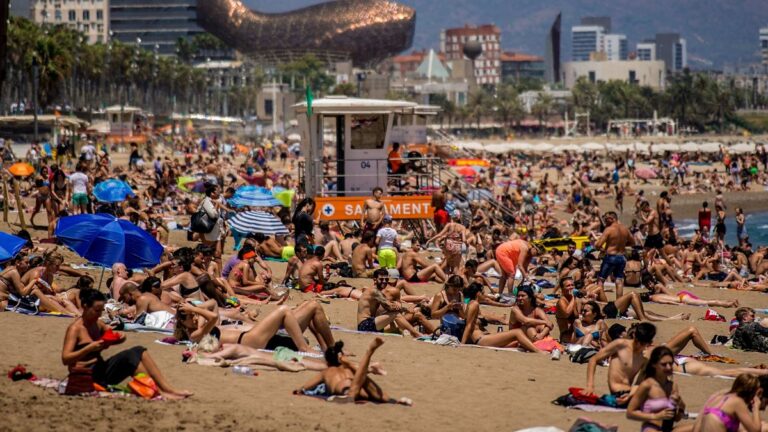As Barcelona emerges from a nearly four-year drought, the aftermath leaves many difficult questions about water management and the realities of mass tourism.
advertisement
Barcelona is experiencing its first rainfall in almost four years, bringing to a close the longest drought in Catalonia since records began, and bringing a much-needed respite with the first “normal” spring and the start of the tourist season.
As reservoir levels rise above previous dangerously low levels, hundreds of thousands of festival-goers will fly to Barcelona in May to flock to Primavera Sound, one of the biggest music festivals in Europe.
The two-week Primavera Sound marks the start of the summer season, which sees tourists flock to the Catalan capital from May through to September.
While recent rains have lifted the drought emergency in the region, the experience has left many residents and officials questioning whether Barcelona’s relationship with tourism will be sustainable the next time drought inevitably hits.
Is tourism subject to water restrictions?
In 2022, Primavera attracted more than 460,000 visitors from around the world, generating revenue of €349 million for the city of Barcelona.
Few restrictions were imposed on the tourism sector as the water situation worsened throughout 2023. As the city closes out 2023, it expects more than 12 million tourists to have stayed in hotels, tourist holiday rentals and hostels, with the Department of Economy and Economic Promotion estimating tourist spending at €9.6 billion.
Tourism is one of the main economic sectors for Barcelona and the surrounding area, accounting for more than 10% of local GDP in 2021 and 5.4% of Catalonia’s overall GDP in 2022.
Tourism is so important to the city’s economy that many questions were raised when the drought emergency was declared in February. Water use is limited to 200 liters per person per day, with additional charges incurred for anything above that limit, and there were few restrictions on the tourism sector beyond emptying swimming pools, warning signs, and water usage advisories.
“We are aware that water awareness campaigns are being carried out in the hotel industry with the aim of raising awareness among customers about water use,” Elvira Garcia, general manager of Barcelona Oberta, the city’s trade and tourism hub association, told Euronews Green.
“In that sense, there are stickers and signs in public restrooms, and showers are recommended to be four minutes long.”
What lessons have been learned from the drought?
While the worst appears to be over, the drought remains a big part of life for residents and is also having political repercussions, with water security being raised by candidates in May’s Catalan regional elections.
Vicens Acuña Salazar, director of the Catalan Water Institute (ICRA), knows firsthand the inequalities that water scarcity has caused, particularly in the tourism sector.
“The drought is not officially over, so we need to see what happens especially next autumn. If next autumn is as dry as the last three autumns, we will have another emergency in the winter and shortages in almost all sectors. But for now, the summer is resolved,” he explained to Euronews Green.
For Vicens and many others, the need to inform tourists about water scarcity, and establishing greater independence from rainfall, are key elements to making Barcelona less susceptible to future droughts.
“We have formed a group with stakeholders from the tourism industry, the Spanish Hotel Association and, hopefully, the Spanish Ministry of the Environment, to develop and start implementing a system to measure water use in tourism activities.”
“Then, when you’re choosing which hotel to visit, you can look at whether the hotel is investing in things like water efficiency or rainwater capture and reuse on-site.”
How is Barcelona adapting to drought?
This is a balancing act between Barcelona’s peak summer tourism period and water usage during the worst of the drought, highlighting how vulnerable the city is to water shortages and why the city’s tourism industry needs better water management strategies.
The Catalan government will invest around 2.5 billion euros in Catalonia’s Water Company (ACA) to manage water supplies and deal with future droughts. The plan, which runs from this year until 2027, will triple previous investments, increase the number of water production plants from 24 to 40, and increase production from Barcelona’s River Besòs.
advertisement
A floating desalination plant will be installed off the coast of Barcelona in 2024, producing 14 hm³ of water per year, or 6% of the capital region’s consumption, and construction of 12 mobile desalination units will begin along the northern Costa Brava from June.
These units, costing 10 million euros, will supply 1,000m³ of water daily and cover 35% of the water consumption of more than a dozen municipalities.
Recent rains have narrowly avoided major changes to Barcelona’s tourism industry, buying it time to prepare for the inevitable “next time.”
“Mass tourism is not part of the urban strategy we want to have. Businesses are aware of the importance of a sustainable path,” Elvira Garcia told Euronews Green.
As increased heatwaves and reduced rainfall affect Spain and much of the Mediterranean region, new approaches need to be implemented to ensure the short-term benefits that tourism brings to local economies and the long-term sustainability of water.
advertisement
Source link

